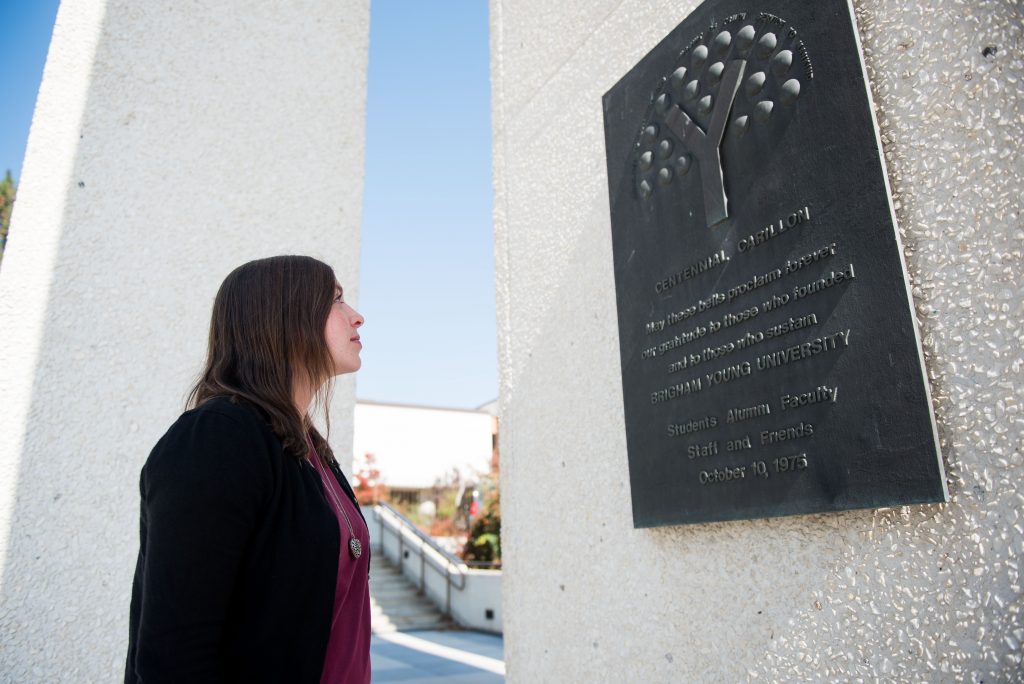
Every day as the hour strikes noon, the sound of ringing bells can be heard throughout BYU. The Centennial Carillon Tower, which turns 42 years old this month, provides a familiar sound to students as they walk around campus.
The bell tower was erected in October 1975 in honor of BYU’s 100th anniversary. The 52 bells in the tower collectively weigh 26,695 pounds. The tower houses the carillon, the actual instrument that uses the bells to make music.
“A carillon is defined as a set of cast, bronze bells of at least 23 in number that are attached to a manual keyboard and can be played expressively,” said BYU professor Don Cook.
A committee chose the carillon as a monument to the BYU campus to commemorate the university’s first 100 years. On Oct. 10, 1975, the Friday of the Centennial Homecoming week, a program was held to dedicate the tower.
The dedicatory prayer was offered by Spencer W. Kimball, who prayed in gratitude for the “diversity of the bells in their size, versatility and music-giving tones; for the clavier and the clappers and the magnetic tape and the keyboard.”
The bell tower stands 97 feet tall. It takes 110 steps to reach the playing room right underneath the bells. The strikes heard throughout campus every half hour are performed by automated mechanisms, but all the music played is performed by live musicians.
Cook serves as the university carillonneur and mentors student carillonneurs. His relationship with the carillon goes back to 1979, only four years after its dedication. Cook was intrigued by the instrument and sought out lessons to learn how to play it. He furthered his carillonneur education at the University of Kansas and returned to BYU as a faculty member in 1991.
Cook’s appreciation for the bell tower goes beyond the music it provides.
“(The bell tower) is, in my opinion, a beautiful building,” Cook said. “It’s striking, it’s picturesque and we try to make the music that it plays something lovable.”
Most often, students perform the noontime carillon recitals. Songs from hymns and famous movie themes can be heard for 30 minutes during the noon hour. On Tuesdays, carillon music is performed before and after devotional.
Graduate student Ariel Peterson Hubbard has been a student carillonneur for the last five years. She believes the Centennial Carillon is more than just an instrument.
“The bell tower is like the Y on the mountain,” Hubbard said. “(It’s) an iconic symbol of BYU that is both a visual reminder and an audible reminder of academic excellence and hope that we can enter to learn and go forth to serve.”
There are only 173 carillons in the nation, and most are located in the eastern United States. The Centennial Carillon is the only instrument of its kind in the state of Utah, making it a landmark that’s important beyond the limits of Provo. Further, the carillon on BYU campus is the only one between Denver and the west coast.
Music education student Kate Carr has an emotional connection to the bell tower. Aside from finding peace at the tower from her time as a freshman in Helaman Halls, Carr found out this summer her parents got engaged at the tower when they were BYU students.

“I had no idea that’s where (my parents) had gotten engaged, but it’s always been one of my favorite spots on campus,” Carr said. “Knowing more about my parents and their experience (at BYU), it’s just made being here more meaningful in some ways.”
The Centennial Carillon Tower is more than just a reminder students are late for class: it represents BYU’s legacy, in addition to the sacrifice made by students of classes long graduated. The tower was funded by contributions from faculty, alumni and students. Without the help of students, the monument’s construction would not have been possible.
Hubbard believes the unity BYU students experience is tied to the spiritual music the carillon provides.
“Whenever I hear that ‘Come, Come Ye Saints’ (on the carillon), I feel united with my fellow BYU students who are pioneers in their families, their fields, their educations, their careers and their missionary efforts, all coming here to BYU as part of our journey to become saints,” Hubbard said.




